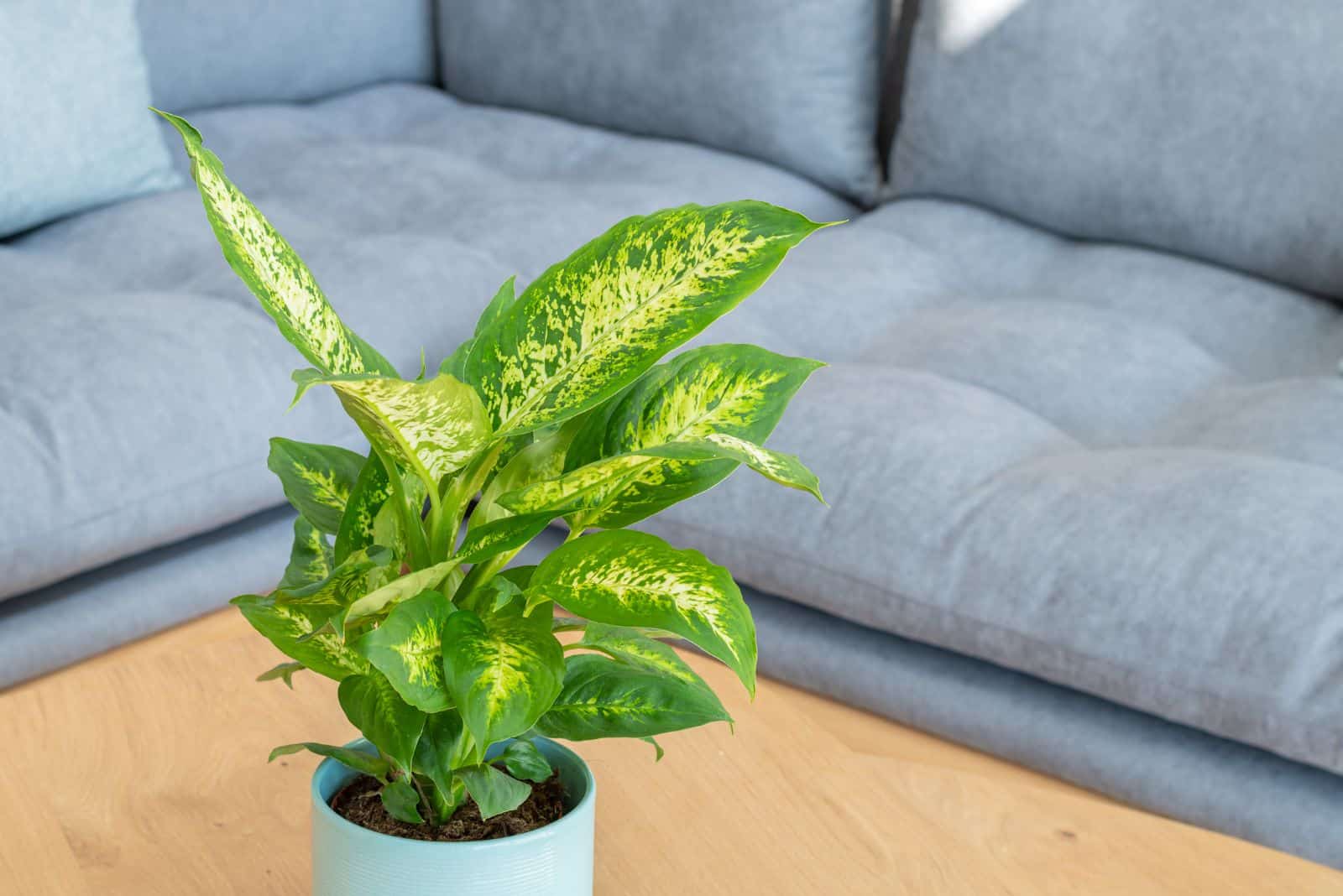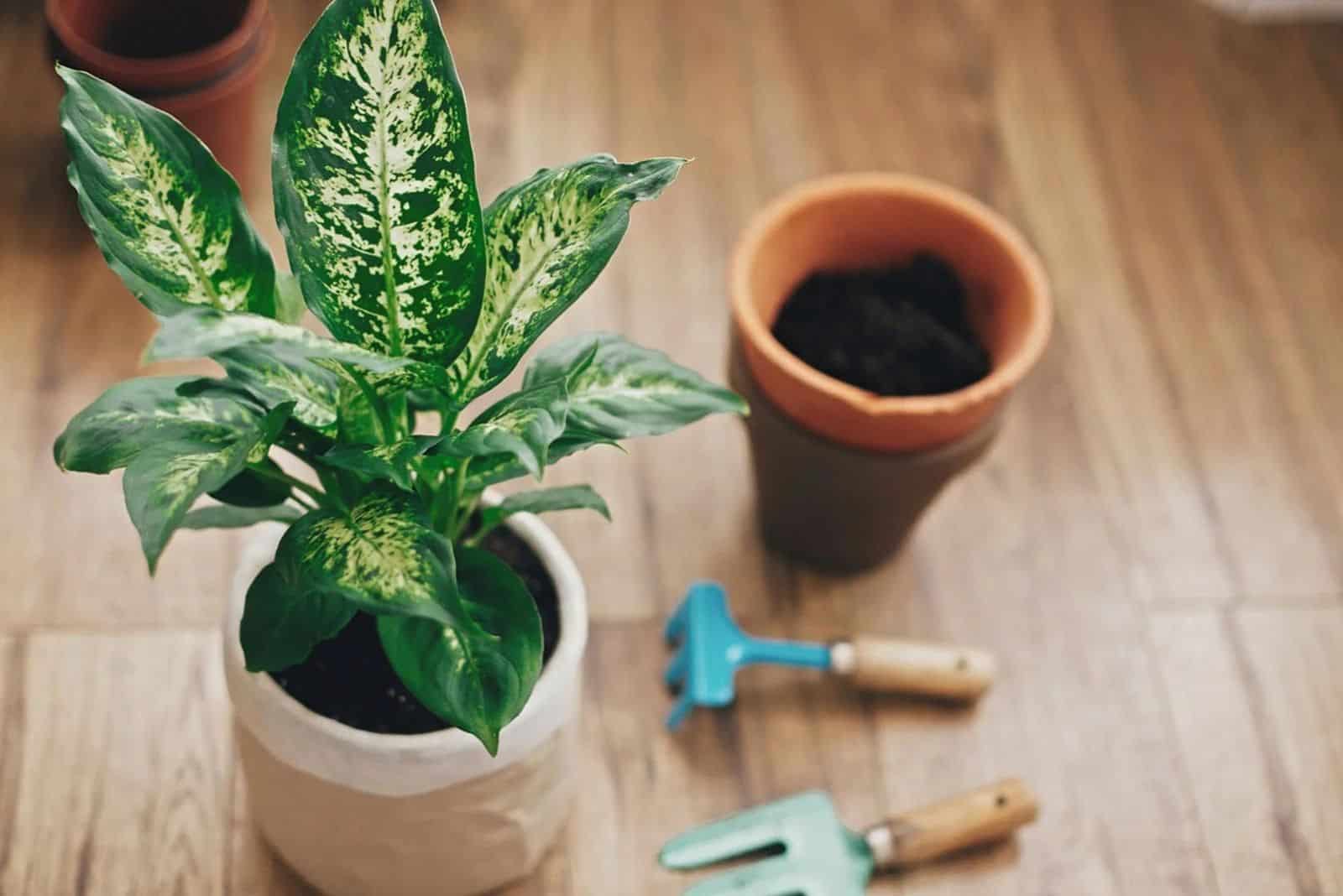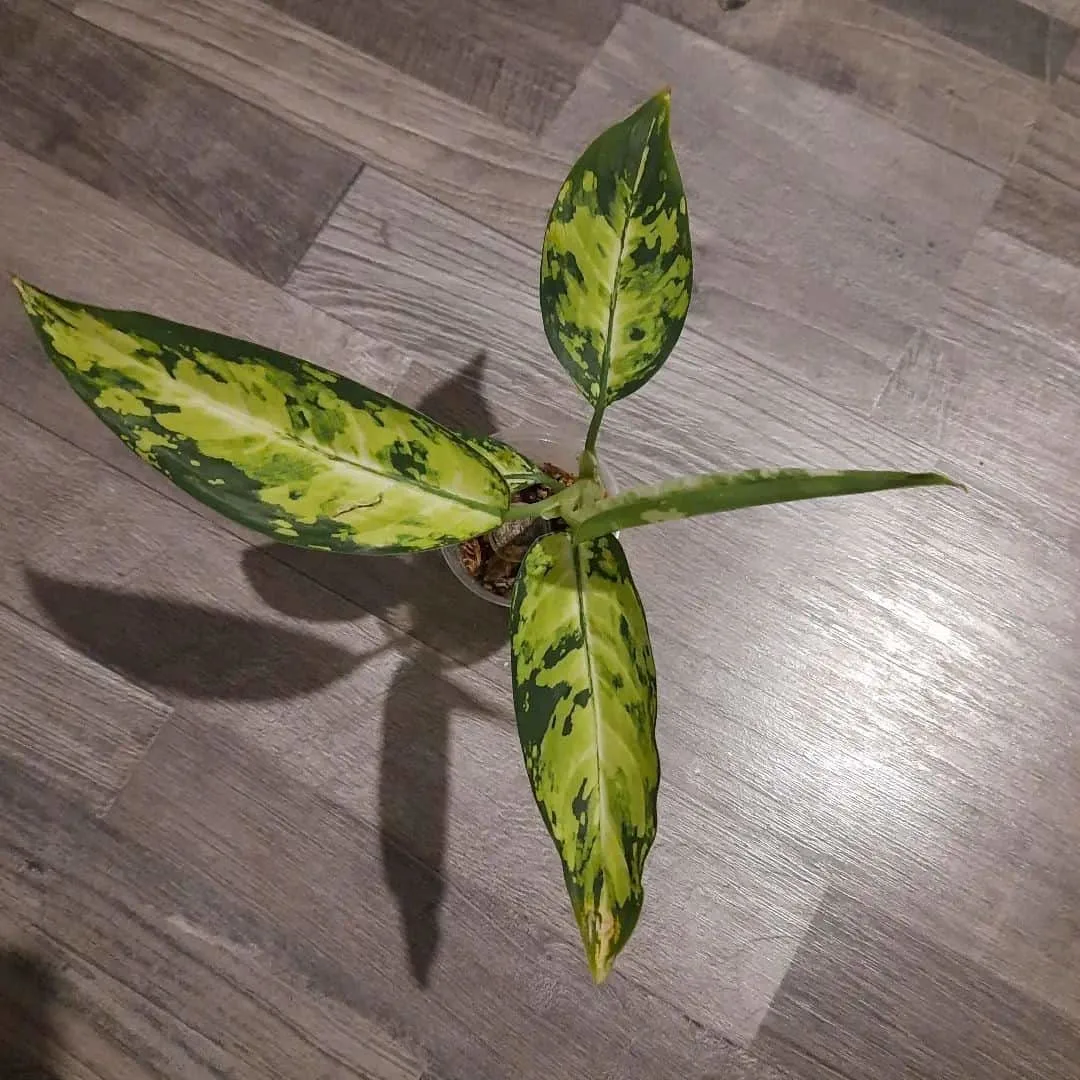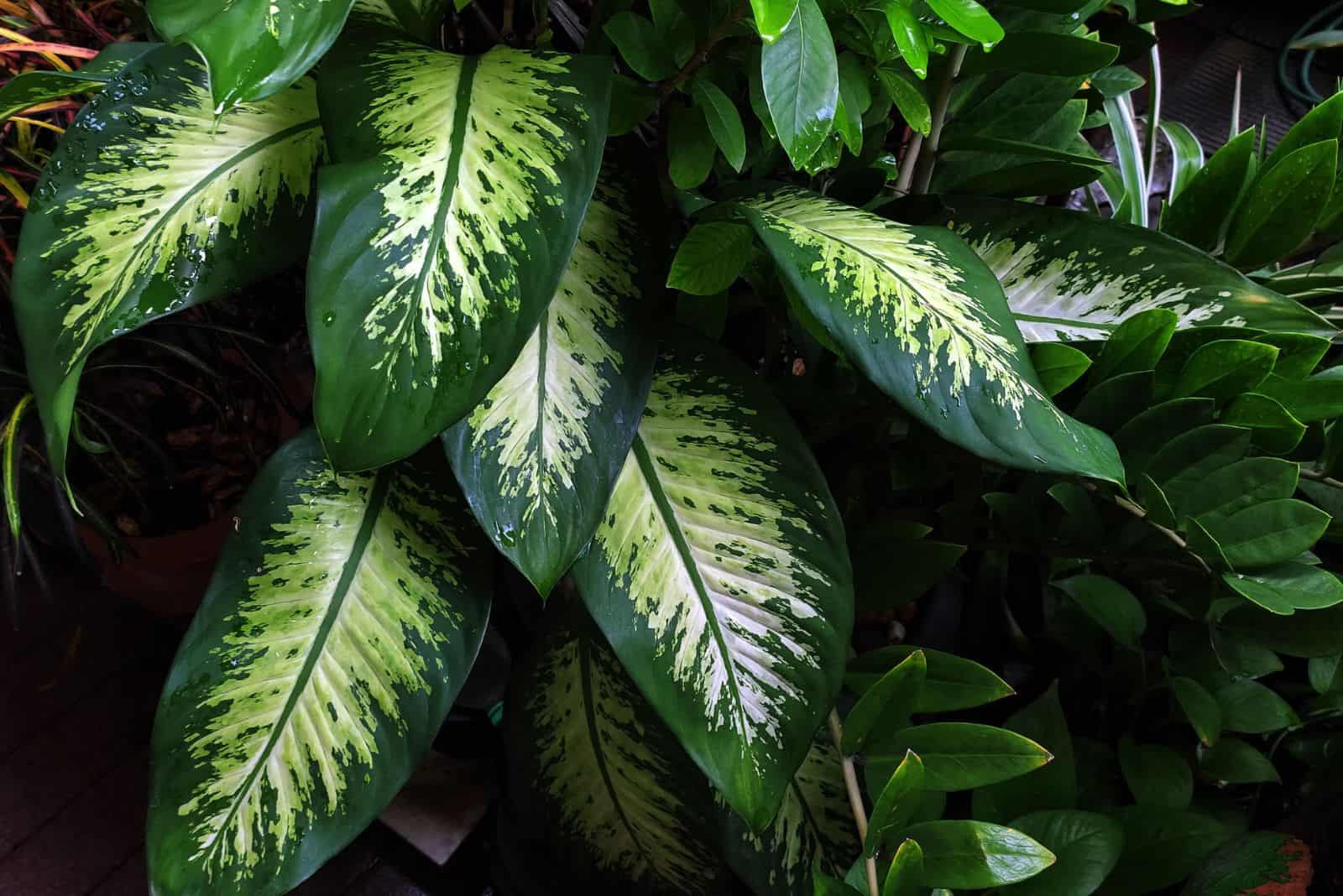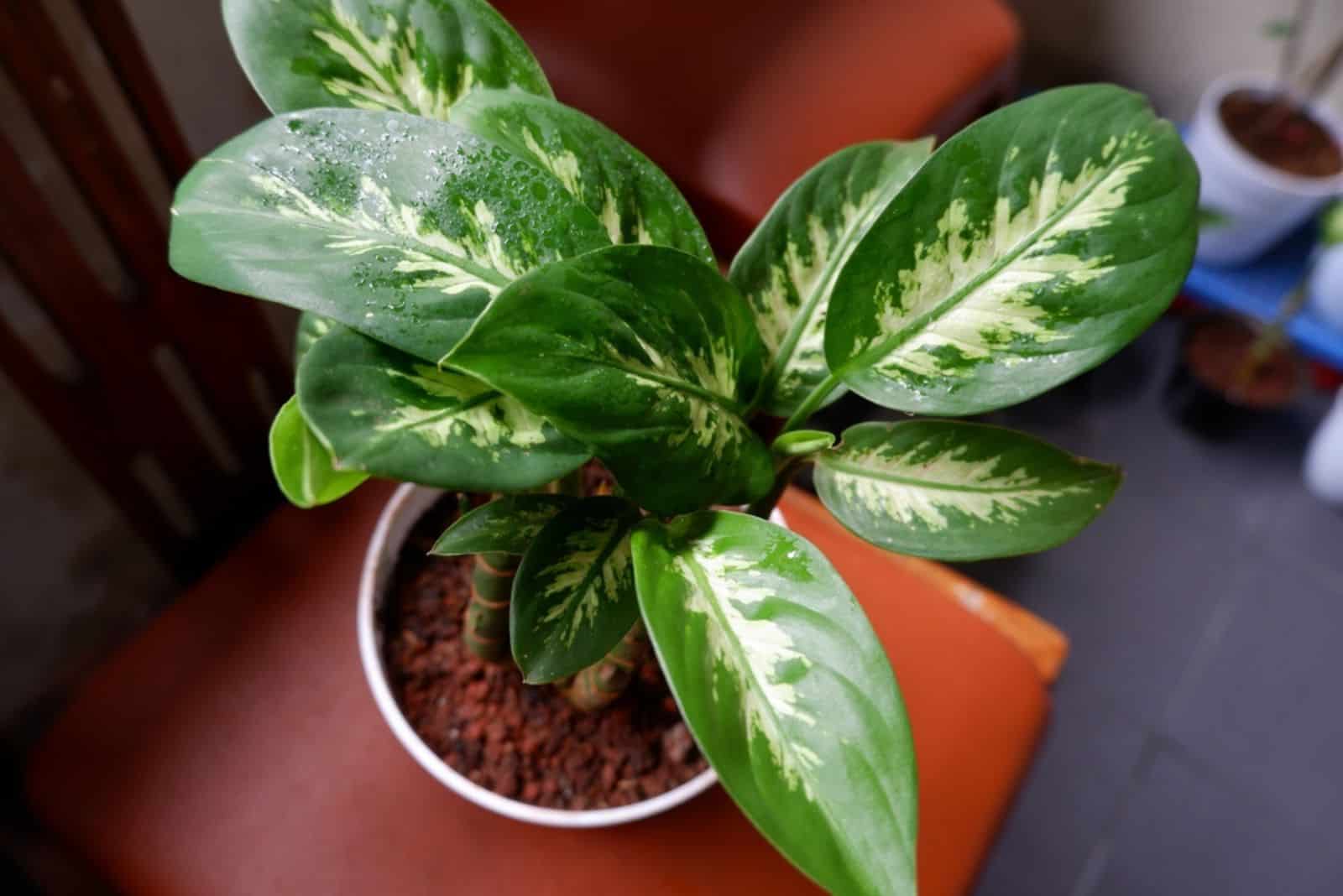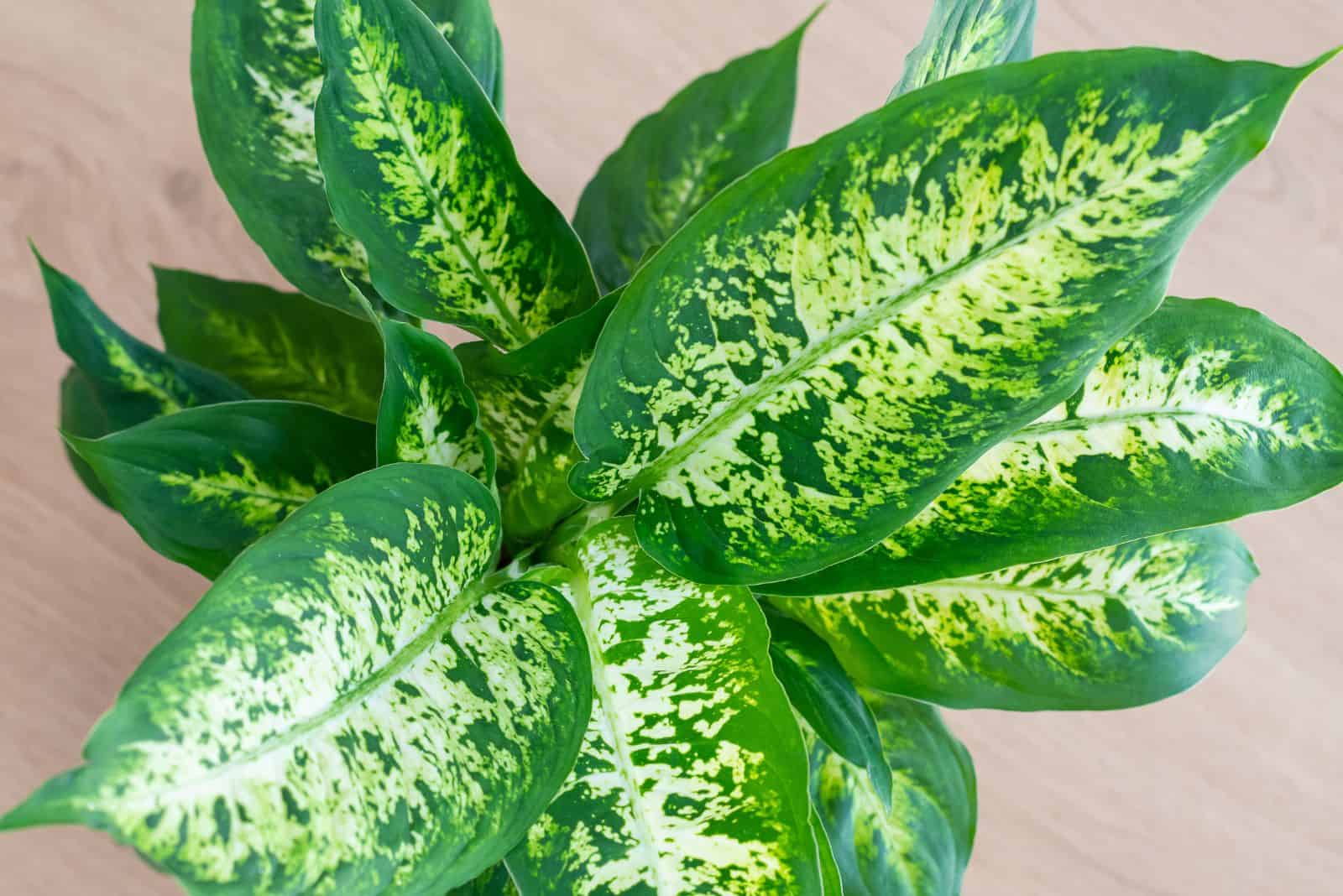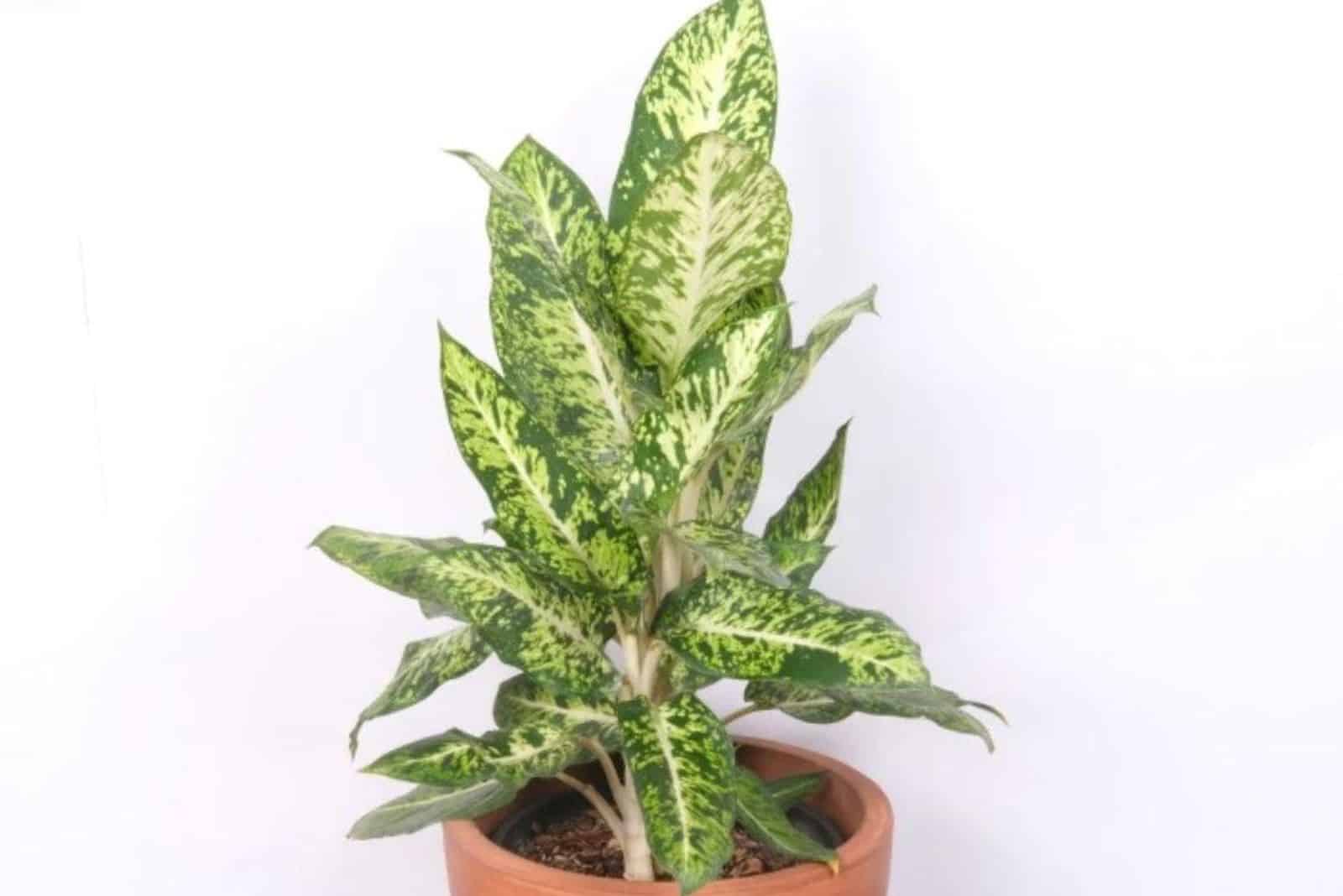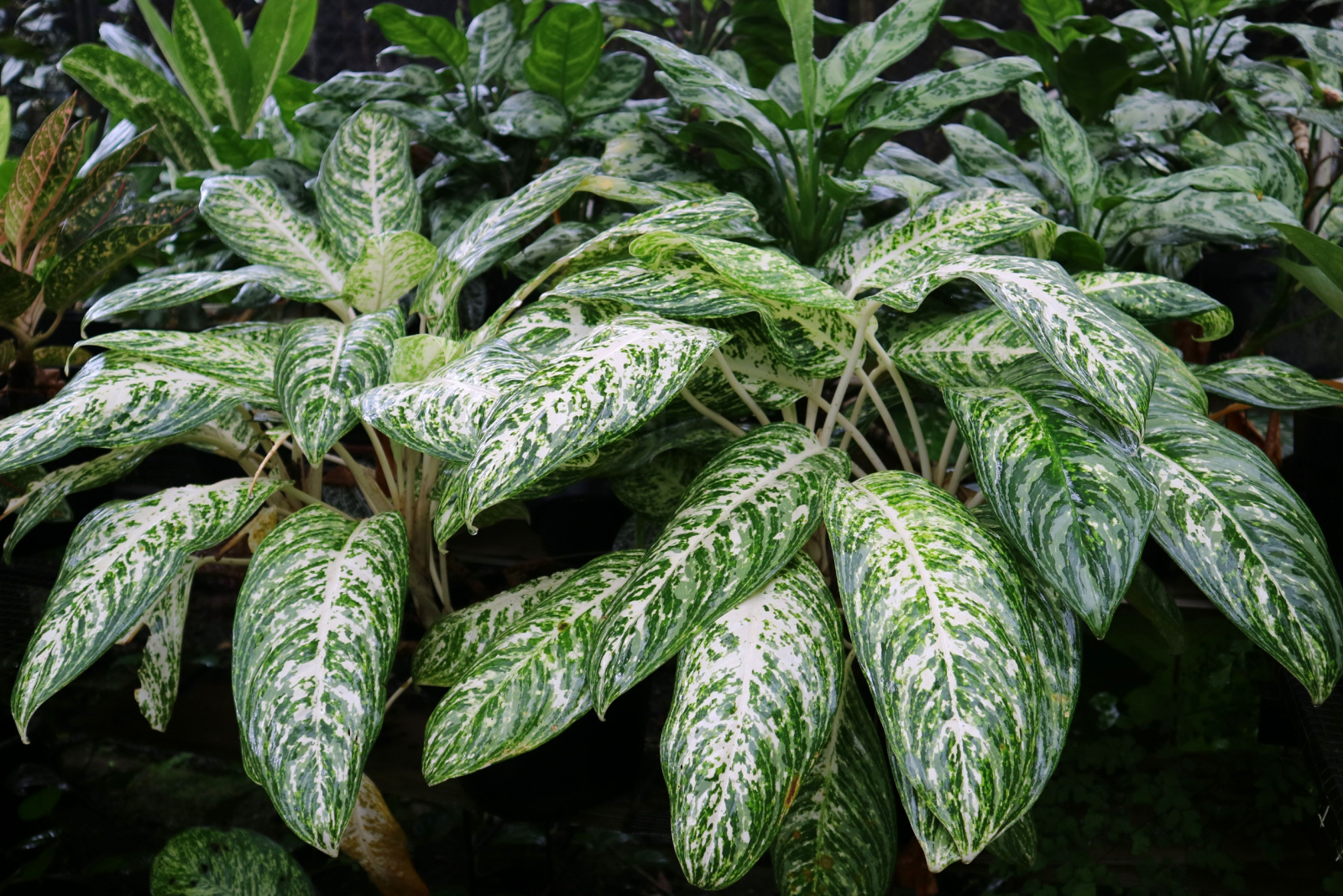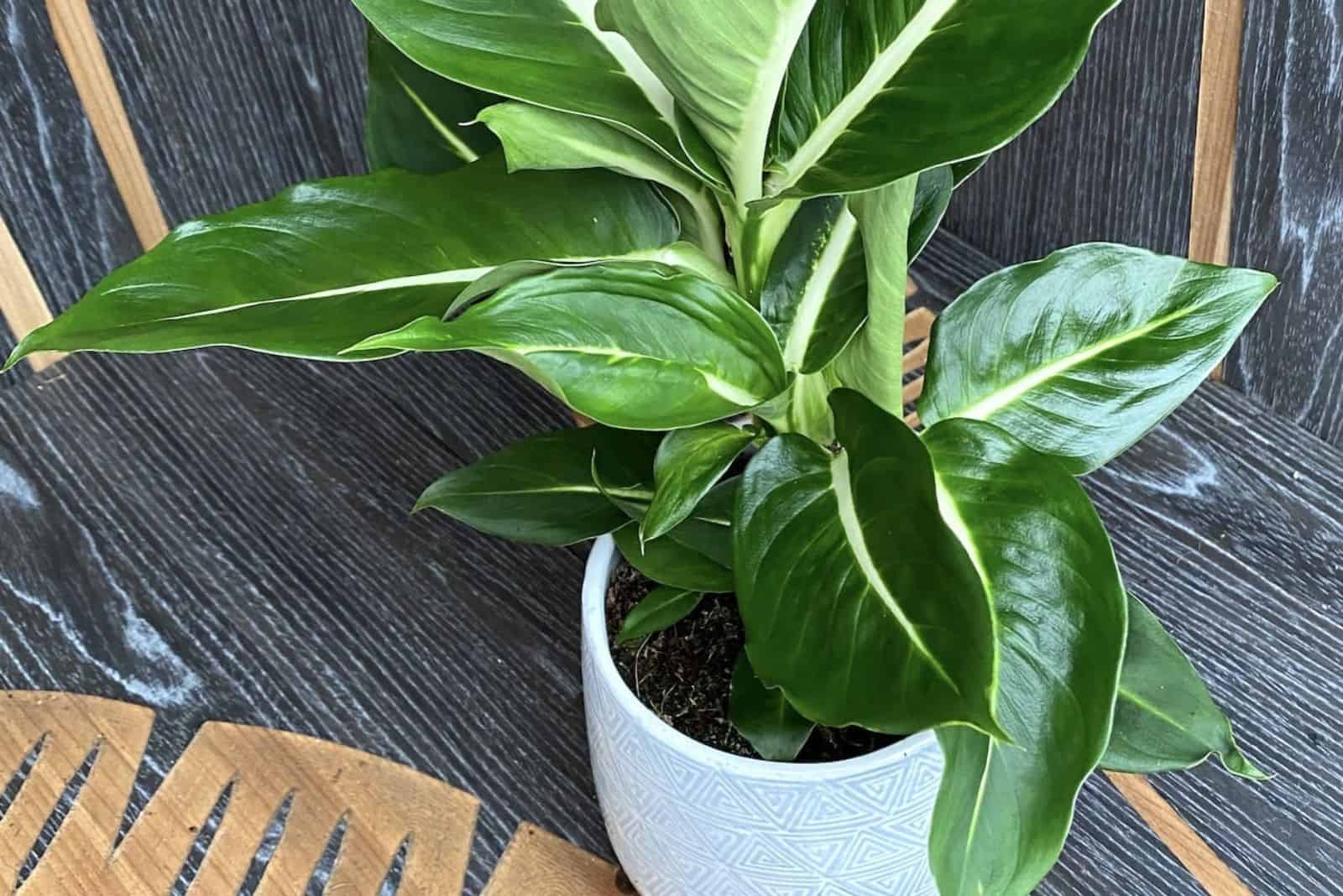The Dieffenbachia also goes by the name, “dumb cane,” and is frequently seen in plant collections worldwide.
These plants have everything a beginner grower could wish for. Dieffenbachias are low-maintenance, tolerate lower light levels, purify the air, help maintain indoor relative humidity, and look amazing!
I prepared a collection of 30 fantastic Dieffenbachia varieties and some tips on keeping them happy and healthy to help you grow this magnificent plant.
Let’s dive right in!
1. Dieffenbachia maculata Tropical Tiki
The first species on our list is the lovely Tropical Tiki. The leaves of this dumb cane plant are massive and come in different shades of green. They are also adorned with creamy speckles along each leaf’s midrib.
The Tropical Tiki reaches up to 30 feet tall in its natural habitat, whereas it can reach approximately 3-4 feet when cultivated indoors.
I have to warn you about light levels because this maculata plant is very sensitive to direct sunlight, so be careful where you put it.
2. Dieffenbachia Rebecca
Some dumb cane varieties, such as the Rebecca, have a more compact shape. What makes the Rebecca stand out is the bold variegation and spectacular combination of bright colors.
Remember that variegated plant species such as the D. Rebecca require more bright light to preserve their variegations.
However, you should never expose these plants to full sun because the leaves can turn yellow and suffer from severe sunburns.
3. Dieffenbachia daguensis
The Daguensis cultivar is hard to find, so if you come across it, don’t miss the chance to buy one. The leaves of this Dieffenbachia are long and pointy, and typically come in deep green.
Each leaf features yellowish patches, which give this cultivar a very unique appearance.
Be careful with the potting mix if you decide to grow this plant. It’s sensitive to overwatering, so make sure to amend the soil with perlite, pumice, or similar well-draining materials.
4. Dieffenbachia Triumph
The next variety is a hybrid known for its stunning deep green and lime green foliage. The leaves of Triumph plants also feature white veinings on the lime-green leaf part.
If you want your Triumph plant to thrive, put it in bright indirect sunlight and a temperature range of 70 to 80 degrees Fahrenheit.
5. Dieffenbachia Aurora
The white blotches and spots of the Dieffenbachia Aurora’s leaves have made this variety very popular among plant collectors.
This species typically doesn’t exceed 3 feet tall, making it perfect for any household. Similarly to its cousins, the Aurora doesn’t tolerate too much moisture in the growing medium and won’t grow well in low or direct sunlight.
Free-draining soil and bright indirect sunlight are the perfect growing conditions for a Dieffenbachia Aurora.
6. Dieffenbachia Camouflage
Now we have the Dieffenbachia variety with the most interesting name – Camouflage – a spectacular dumb cane plant with green oval-shaped leaves adorned with veinings and dark blotches.
You can find Camouflage varieties in different shades of green, depending on the cultivar.
If you have a cultivar with bright shades of green, you need to ensure more bright light, but keep it away from the full sun.
7. Dieffenbachia Carina
The broad Dieffenbachia Carina leaves are adorned with green and creamy blotches that have spots all over the surface.
This variety isn’t fussy over the growing conditions and will even grow well if faced with drought for a short period of time.
For best results, water your Dieffenbachia Carina when the top 2-3 inches of the soil dry out. Additionally, keep the temperatures in the recommended range of 70 to 80 degrees Fahrenheit.
8. Dieffenbachia Tropic Snow
Although the words “tropic” and “snow” don’t seem to go well together, they fit this Dieffenbachia perfectly.
Growers often confuse the Tropic Snow For the Tropical Tiki. The difference is in the color and shape of the leaves; the Tropic Snow has massive oblong leaves and fascinating variegations in gold.
When all conditions are favorable, the Tropic Snow can exceed 6 feet tall, making it one of the largest Dieffenbachia varieties.
Of course, if you want to control its growth and size, you can always prune your Tropic Snow.
9. Dieffenbachia Honeydew
The Honeydew Dieffenbachia is one of the most famous plants in this genus and is quite popular among plant collectors.
The broad leaves of the Honeydew variety have deep green margins and yellow centers.
This variety enjoys high humidity levels; anything above 50% will do the job. You can use a humidifier, put a pebble tray below the Honeydew’s container, mist the leaves regularly, or move the plant to a kitchen or bathroom.
10. Dieffenbachia Camille
Now we have a very young dumb cane variety, the Camille. This is a low-maintenance plant that can reach 3 feet tall under optimal conditions
The leaves of the Camille variety are massive and have creamy centers with light green edges.
I have had this variety for a while now, and I can tell you that it does best when fed regularly during the growing season. I use a balanced triple 20 fertilizer diluted to half strength.
11. Dieffenbachia Panther
The leaves of the Panther Dieffenbachia are a very deep green and perfectly combine with the speckles that come in white and different shades of green.
The Panther variety doesn’t exceed 3 feet tall, so it will fit well even in smaller apartments.
Due to its small size and low light tolerance, this Dieffenbachia is the perfect plant for offices without windows. It requires a free-draining and slightly acidic growing medium.
12. Dieffenbachia Amoena
The Amoena is a parent plant of the Tropic Snow cultivar. Its minimum size indoors is about 6 feet and the leaves can reach 20 inches long under optimal conditions.
The leaves of the D. Amoena are oval-shaped and have creamy to yellow variegations, dark green spots, and streaks near the veins and edges.
When watering your Amonea, always check the soil moisture content and only irrigate when the top 2 inches are dry. You can check moisture using your fingers, a bamboo stake, or a moisture meter.
13. Dieffenbachia Mary
Another spectacular Dieffenbachia species is the Mary. The bright green leaves have creamy or deep green blotches all over the surface.
The Mary Dieffenbachia typically reaches 4 feet tall and won’t produce flowers when grown indoors. If you live in USDA hardiness zones 10 through 12, you can cultivate your Dieffenbachia Mary outdoors.
Never expose your Mary to direct sunlight no matter where you grow it; find a spot with partial shade if you cultivate it outdoors.
14. Dieffenbachia Sarah
This dumb cane plant has stunning variegated foliage. The edges are deep green and the center is adorned with creamy white blotches.
The Sarah Dieffenbachia thrives at temperatures ranging from 65 to 75 degrees Fahrenheit. It doesn’t need much water, especially during colder months.
Just like all other dumb cane plants, the Sarah is toxic to pets (1), so make sure to keep it out of reach of your furry friends.
15. Dieffenbachia Snow
The snow variety is among the tallest Dieffenbachias and can reach 6 feet very quickly. The leaves are deep green and have silverish or creamy-white blotches.
The Snow Dieffenbachia is a plant you can grow in water. Of course, it won’t reach its normal size in water, but with regular feeding and enough bright indirect sunlight, it will be a happy and thriving plant!
16. Dieffenbachia Compacta
As the name suggests, this Dieffenbachia is more compact. It won’t exceed 19 inches tall, making it one of the smallest dumb cane plants.
The massive, creamy foliage is speckled with green, giving the Compacta variety a unique appearance.
If you need a smaller plant for a table or shelf, a Dieffenbachia Compacta is the perfect choice. Of course, the light level needs to be adequate; if the plant lacks sun exposure, consider using artificial lights.
17. Dieffenbachia Tropic Marianne
We now have another dumb cane variety with the word “tropic” in its name. Meet the Tropic Marianne, the Dieffenbachia plant with large yellow foliage and green margins. This variety typically reaches 30 inches tall, making it suitable for smaller apartments.
Even though plants from the Dieffenbachia genus tolerate low light well, I highly recommend putting your Tropic Marianne in a spot with a lot of bright indirect sunlight.
Just like all its cousins, the Tropic Marianne is an air-purifying plant, which means it removes harmful substances such as toluene from the surrounding air. (2)
18. Dieffenbachia Delilah
Hey there, Delilah! This is a pretty uncommon Dieffenbachia variety and definitely the one I never mistake for any other.
The leaves are elongated and have green margins with entirely white centers. I love plants with leaves that have a white color, but there’s one tricky thing about this feature; due to the lack of chlorophyll, these kinds of leaves typically need more light. Direct sunlight is still a no-no, but low light isn’t a good choice either.
The Delilah is also a fairly pest-resistant variety due to its thick, waxy leaves. The plant has a fast growth rate, making it perfect for impatient plant parents.
19. Dieffenbachia maculata Exotica
This is a close cousin of Tropical Tiky, the lovely dumb cane Exotica variety. The parent plant is the Dieffenbachia maculata.
This variety has an upright growth habit and typically reaches 2 feet tall when grown indoors. The center of each leaf is creamy and the edges are deep green. The leaves look very similar to those of the Camille variety, but with more green.
You need to plant your maculata Exotica plant in a free-draining, fertile growing medium to ensure it gets enough nutrients for further growth.
20. Dieffenbachia Sparkles
Sparkles is a dumb cane variety made in a tissue-culture laboratory for commercial foliage production (3).
This variety has lovely, lightly variegated leaves with green margins and white midribs. It’s perfect for novice gardeners since it tolerates different growing conditions.
You should keep it in indirect light and moderate to high humidity, plant it in a free-draining growing medium, and irrigate it when the top 2 inches of the soil dry out.
21. Dieffenbachia Star Bright
What makes the Star Bright Dieffenbachia special is its narrow foliage, which is pretty uncommon for plants from this genus.
Each leaf of this Dieffenbachia has a different pattern; the speckles come in dark green, white, yellow, and lime green.
Make sure you don’t overwater your Star Bright because the roots can quickly rot if excess water doesn’t drain from the growing substrate.
This variety also won’t tolerate even short periods of frost, so only keep it outdoors if you live in USDA hardiness zones 10-12.
22. Dieffenbachia x bausei
This dumb cane variety is quite old and has been a target of plant collectors since 1873. The leaves are velvety and come in yellowish-green with deep green margins and speckles.
The Dieffenbachia x bausei variety needs constantly moist soil. Still, the roots are sensitive to pathogens found in standing water. You can quickly fix this issue if you amend the soil with well-draining materials such as perlite or pumice.
The great thing about these plants is that you can propagate them with 2 straightforward methods, stem cuttings and air-layering.
23. Dieffenbachia Sublime
The sublime is a dumb cane variety that has ovate leaves with light and deep green variegations. This evergreen makes a perfect addition to households and also looks amazing when cultivated outdoors.
Remember that outdoor growing is possible only in USDA zones 10 through 12. If you live in a slightly colder climate, you can keep your Sublime Dieffenbachia outdoors and move it indoors when temperatures drop below the recommended level.
Generally speaking, the Sublime variety doesn’t need regular pruning, but you will need to remove any discolored or damaged leaves.
24. Dieffenbachia Sterling
The D. Sterling is another fascinating variety. Its leaves are green and have accentuated, creamy or yellowish main veins.
It tolerates different light levels but not the direct sun. The easiest and best way to propagate the Sterling variety is by using stem cuttings.
Here’s a video with more tips for Dieffenbachia Sterling care:
25. Dieffenbachia Memoria Corsii
The combination of silver and green colors on the Memoria Corsii leaves have made it a very popular houseplant. When mature, this Dieffenbachia reaches 4 feet in height and can spread up to 3 feet.
It’s an air-purifying plant, but you need to keep it somewhere safe since it’s toxic to pets. Never allow the soil to dry out entirely; irrigate your Memoria Corsii as soon as the topsoil is dry to the touch.
The best growing substrate for this dumb cane plant is one made of equal parts peat moss, perlite, and sand for gardening.
26. Dieffenbachia White Etna
One of the rarest Dieffenbachia varieties is the White Etna. It has oval-shaped, deep green foliage adorned with mottled variegations.
Be careful with light levels because this variety needs more sun exposure to preserve its white variegations. For instance, you can place your White Etna Dieffenbachia near a south-facing window and put up sheer curtains to filter the light a little bit.
Also keep humidity in the recommended range for Dieffenbachia plants.
27. Dieffenbachia White Flame
This is a dumb cane variety that has beautiful ovate leaves with deep green edges, a light green middle part, and a white midrib.
This Dieffenbachia typically doesn’t exceed 2 feet tall, making it perfect for smaller spaces.
You can have a perfectly happy and healthy White Flame by planting it in compost based on loam.
I also recommend feeding your White Flame using a balanced liquid fertilizer.
28. Dieffenbachia Puerto Rico Variegated
This is another exotic Dieffenbachia, the Puerto Rico Variegated species. It has lanceolate leaves with white splashes all over the surface. The margins are green and you can notice a bit of a yellowish tinge now and then.
Even though the Puerto Rico variety tolerates lower light levels, you will notice more green on the leaves as a response to a lack of bright light.
29. Dieffenbachia Imperialis
This dumb cane plant is native to Peru. It has captivating, oblong leaves with green and white variegations. The more light your Imperialis receives, the more white you’ll see.
It can reach up to 6 feet tall in optimal conditions. The Imperialis is a tropical species and enjoys a humid environment. You must keep humidity levels above 60% to maintain its vigor and color.
You can multiply your Imperialis Dieffenbachia using stem cuttings.
30. Dieffenbachia Green Magic
We’ll finish off our list with the Green Magic dumb cane variety. The leaves come in deep green and have a creamy white main vein.
The Green Magic is a perfect plant for desks or shelves in offices since the mature size is approximately 3 feet.
This dumb cane plant can withstand a short period of drought; if you notice wilting and drooping, just give your Green Magic a good soak and it will recover quickly.
Wrapping Up
Dumb cane makes a perfect houseplant and can be found in plant collections worldwide. It’s super easy to maintain, looks breathtaking, and purifies the air. Unfortunately, all plants from this genus are poisonous to pets.
I’ve shown you 30 wonderful Dieffenbachia varieties, so if you don’t have furry friends or can keep the plant out of their reach if you do, simply pick the variety that suits you most.
Use our care tips and I’m sure your Dieffenbachia will be happy and healthy for a long time.
Until next time!
References
1. Dieffenbachia. (n.d.). ASPCA. https://www.aspca.org/pet-care/animal-poison-control/toxic-and-non-toxic-plants/dieffenbachia
2. Porter, J. (1994). Toluene removal from air by Dieffenbachia in a closed environment. Advances in Space Research
3. “Sparkles” Dieffenbachia. (n.d.). https://mrec.ifas.ufl.edu/foliage/breeding/sparkles.htm#:~:text=’Sparkles’%20Dieffenbachia%20is%20intended%20for,exceptionally%20well%20in%20interior%20environments.

